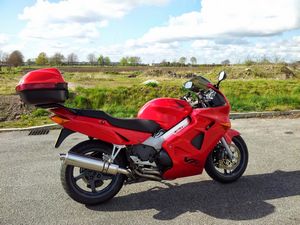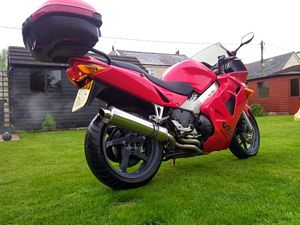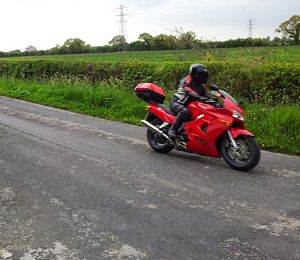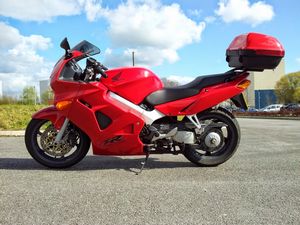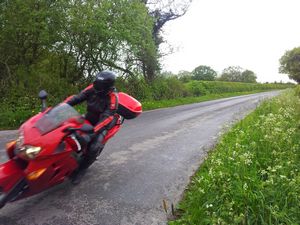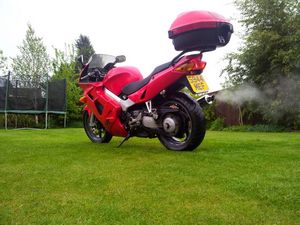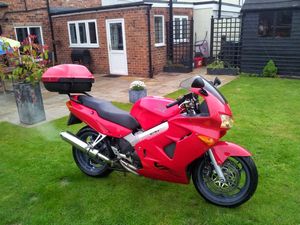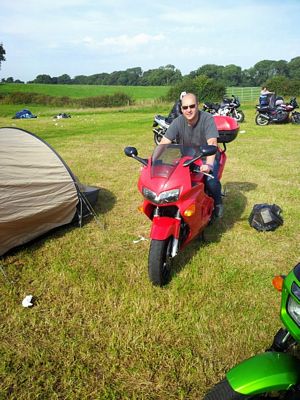|
By accessing or using The Crittenden Automotive Library™/CarsAndRacingStuff.com, you signify your agreement with the Terms of Use on our Legal Information page. Our Privacy Policy is also available there. |

Living with - Honda VFR 800
|
|---|
|
|
Living with - Honda VFR 800
Colin Hubbard
Speedmonkey
May 22, 2013
The Bike - Honda VFR 800 FI-W 1998
the Owner - Colin Hubbard
Early in 2011 and after a break from motorcycles for a few years I fancied another bike to enjoy. The parameters were that it had to comfortable, practical, reliable and ultimately fast.
My search took me to Honda for reliability and Germanic-surpassing build quality and specifically the VFR 800 for the practicality and performance. It is renowned for being a good all round tool capable of a fast blat around a race circuit or loaded up with gear and touring around Europe.
If you haven’t owned or ridden a motorbike in the past then you won’t have experienced the rush of a powerful motor with little weight to propel. There’s no need for a large motor on a motorbike and a couple of thousand pounds will get you supercar acceleration and a free supply of goosebumps.
I have owned 6 bikes in the past and knew what to look out for. Personally I like to buy private so you can get an insight into the vehicle's background and haggle on the price. I saw a 1998 S reg VFR800Fi in red advertised in Autotrader and local to me so got on the phone. The guy offered to bring the bike to me to have a look at so off he rode from his home whilst I counted some readies.
The bike was just as advertised, in fairly good nick, not perfect but then is was 13 years old and with a full stainless steel exhaust and after a little haggling we agreed on a price just over £2k and he got the train home. Both parties happy.
So that evening I had a good look at her and the stats which make for pretty impressive reading for a sports touring motor. Sixty is annihilated in 3.4 seconds and it tops out at over 150 mph thanks to 110bhp and 59 torques (motorbikes do not need as much torque as a car due to the lack of weight).
Theres a single sided swingarm for easier rear wheel remove and some linked brakes which means when you use either the front or rear brake and the other end is also lightly braked which is a useful safety feature to stop you locking up a wheel. The bodywork looks purposeful with a full fairing to provide wind protection to the rider with a wide seat for comfort for both rider and pillion over distance.
The next day I took her out for a proper run and it lived up to all the expectations and some, there’s more than sufficent power to ensure rapid overtaking of slow and not-so-slow traffic, with secure but tidy handling and comfort in abundance.
The motor deserves particular praise being a V shaped FouR cylinder (hence the VFR name) and with 2 cylinders facing forward and two rearward split 90 degrees. The packaging was tricky so the radiators had to be installed at the side of the bike and the wheelbase is longer than a true sports bike, but that’s a good thing as it’s more stable on a run.
The engine is derived from the Honda racebike engine, the RC45, so has heritage straight out of the box. The power is strong from low revs and increases in steps up to the 11,750 revs per minute redline with increased urgency at the top end. It is nicely geared from the factory so you don’t end up going shift shift shift on full-bore starts and spending more time changing gear than using the power.
The noise is exotic, and more vocal now I have removed the baffle from the end can, and best described as being like a cross between a machine gun and sewing machine due to the firing order of the V four powerplant. It’s tone varies probably 4 or 5 times throughout the rev range so it’s fun to be able to guess the number of revs from the engine note.
When you back off the throttle completely using the engine braking with zero throttle at about 4000rpm it makes a glorious thumping noise akin to a large bore Ducati 916 V twin, but at about three quarters of the volume of the Italian stallion.
This being the earlier non-VTEC (and some say the better bike) it doesn’t have the great step in power when the extra valves and aggressive camshaft profile kicks in, which is a good thing in my opinion as VTEC technology is not suited to a vehicle with only 2 wheels and more importantly only 1 driven wheel.
Picture this - nice smooth but damp corner, accelerate out and the VTEC kicks in and the back end suddenly has to deal with instant increased power at a time when you really don’t want it. I prefer to modulate the power with the throttle and gears connected to a powerfully smooth non-VTEC engine.
Surprisingly the fuel economy isn’t as great as non-bikers may expect. I achieve about 40 miles per gallon on my commute with up to 45mpg on the motorway, it doesn’t help when the engine's pulling 5500rpm when doing 70mph. Ideally it could do with a further gear to drop the revs for cruising.
Typical range on a full tank is about 180 miles but I have to stop before that point with arse and wrist ache due to being in exactly the same position for over 2 hours.
The handling is safe and secure as a sports tourer should be as it has to be a compromise between sports bike nimble handling and touring bikes long term comfort. I would confidently say it’s the best of both worlds and will corner really tidily with little suspension travel, with the rear monoshock hiding the bikes weight. The brakes are sharp, being 6 pots at the front and a 3 pot at the rear and the linked brakes mean that you rarely get into trouble.
I have never locked up the rear wheel apart from on my gravel drive. It does the distance brief well with good wind protection from the fairing and screen and a comfortable riding position with just the right amount of weight on the handlebars and knees not up by your chest like a sportsbike but straight out in front of you.
Over the past few years I have improved the bike to make it easier to live with on a daily basis - some cosmetic and some for comfort. The first job was to get a topbox fitted and I sourced a second-hand one from a later model which didn’t fit the rack I had. This was resolved by bolting it direct to the rack. It doesn’t bother me that it can’t be removed as I would never take it off as it’s so handy for filling with shopping, storing your helmet and gloves in when out and about and keeping your phone and wallet safe from the elements.
Being the same colour as the bike helps it look factory-fitted but I still get the odd ‘pizza box’ comment which doesn’t phase me due to its benefits. I counted these comments with how car drivers wouldn’t cope with no boot, glovebox, door pockets or passenger seat to store shopping, phone etc??
Now the best invention on a bike, if not since they first automated bread-slicing is heated grips. They are brilliant and very easy to fit - remove the old ones, slip the new ones on with a little glue, mount the controller on the headstock with adhesive pad and run the wires near the battery. I connected it directly into the fuse box and took a lead that only supplies power when the ignition is on so I can’t drain the battery by leaving them on. There are 6 heat settings and on days when the temperature's just above freezing are an absolute godsend. Gloves can’t keep your hands warm when you factor in windchill to already low temperatures so these beauties mean you can concentrate on your riding instead of how cold your hands are.
Next up was a ‘double bubble screen’ which is higher than standard to reduce wind turbulance to the rider. Unfortunately when I fitted the dark smoke screen I hated it. It ruined the lines of the bike so had to go and I accepted the extra wind rush. The wheels were looking tatty- being 12 years old - so I had them powder-coated. The shop didn’t have many colours and the one I picked I hated when I first saw them. I decided to fit them and see if they grew on me, which they have a little and don’t bother me now but I would like to get painted in anthracite when the tyres both need changing.
In December Mr Clause kindly sent me a Scottoiler and that was fitted on Boxing Day in about 2 hours. It’s quite easy to install - tap into an engine-fed vacuum pipe from the engine, mount the oil container under the seat and run the nozzle to the rear swingarm. Position the nozzle near the back sprocket and the centre of the chain and centrifugal force means the oil fully lubes the chain. It takes a few weeks to get the correct flow rate, which is easily adjusted via the reservoir and hopefully will give the chain a longer life and reduce the frequency I have to adjust it.
The last mod was the horn. Motorcycle horns have the volume of a child’s bicycle horn and for something as vulnerable as a motorcycle are totally inadequate. Listen up manufacturers, fit better horns OR at least let buyers have the cost option to factory upgrade as I guarantee a 75% take-up rate. I fitted a Wolo Bad Boy air-horn, fairly easy to wire in with a new relay fed from the original horn wiring and a new power feed from the battery and find somewhere to mount the bulky beast. Job done fairing on and ready to warn off the sleeping, blind or texting drivers.
I carry out my own maintenance and essential servicing, ensuring regular oil changes with the correct oil along with other jobs dictated by the Honda Service manual. My Haynes manual is my bible and a cheap but great point of reference - but then the internet is also full of helpful people and essential tips.
The one job I wasn’t prepared to tackle was the valve clearances which were due shortly after I bought the bike. If I mess them up it could kill the engine so it went off to Honda who relieved me of £250, but I have peace of mind it’s been done right.
The most technical job I have done on the bike (probably ever) is to bleed the brakes. Think car, easy, there are 4 bleed nipples, one at each corner. Think VFR 800 with linked brakes and there an unbelievable 8 nipples that need to be bled in sequence and then repeated.
The system works by applying some front brake when the rear brake is applied and vice versa. When the front brake level is applied it puts pressure to 4 pistons in each front 6 piston caliper and a secondary master cylinder on the front left fork applies pressure to a single piston in the rear caliper when rotational movement is experienced.
Separately the rear foot brake operates 2 further pistons in the rear caliper and 2 of the pistons in each front caliper. All in all after having to remove each caliper and hold upside down to remove the air, bleed in combinations of rear footbrake to front caliper and front brake to rear caliper - all whilst the rear wheel off and balancing over the bike holding up a bottle of clean fluid to bleed into I needed a massive brew and felt like I should be awarded a ‘VFR800 brake bleeding badge’ to sew onto my leathers.
Other jobs need to be done and it’s handy to be able to do myself, one to save money and two to ensure they have been done and with the right parts. Essential winter maintenance involves removing the rear swingarm and greasing the pivot points so all works as it should. Also the front headstock bearings need regular grease and in fact this year needed replacement bearings which made it steer cleaner.
Future jobs planned for the winter when it goes into hibernation are to remove the rear monoshock and front forks and send them off for a rebuild to replace the 15 year old internal oil and fit new seals. This should transform the handling as oil goes off after time and a reputable company such as Brook Suspension will ensure they will be better than new with a more modern oil and many years of experience. In addition I plan to strip the brake calipers and fit new seals to ensure they brake as well as they do when they left the factory. I just hope I don’t need to bleed those darn brakes again afterwards!
Costs. What with the original purchase price of just over £2,000 I have probably spent £500 on accessories and £700 on servicing parts, tyres and labour (valve clearances) but this is fairly small fry when compared with a car's running costs and my accessories can all be transferred to new bike or sold on should I fancy something new. With mpg at 40’ish, insurance at £80 TPFT and road tax at £76 a year it's cheap motoring which is so much fun.
I would hand on heart recommend the VFR 800. It’s a cracking all rounder that’s cheap to run and the ONLY vehicle I have ever owned where I am not left dreaming after something better or planning its replacement. I can’t think of anything else that comes close to what this bike can offer short of spending £14,000 on a brand new BMW GS1200 which is the latest 2 wheeled Holy Grail.
In addition if you have never had the pleasure of riding a motorbike I would wholeheartedly recommend it, be it riding on a scooter or riding off-road. Nothing comes close to the fun, enjoyment and adrenalin you experience on 2 wheels. Forget your Alton Towers and high performance cars which cost an arm and a leg to buy and run, instead use some small change for a life changing experience on a daily basis.

















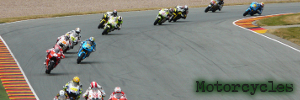 Topics: Honda VFR 800
Topics: Honda VFR 800
